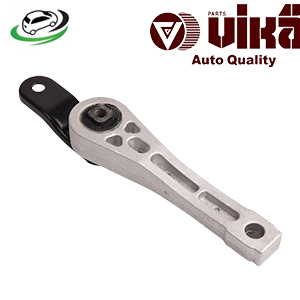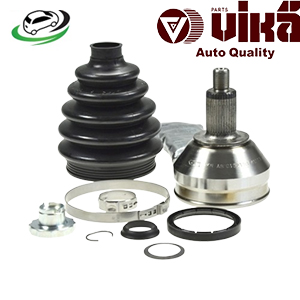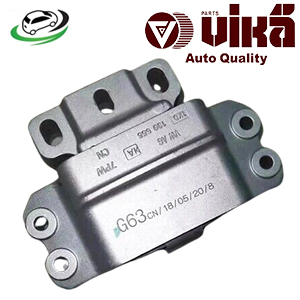-15%
Get Left Transmission Mount VW Golf V 2.5/VW Jetta V 2.5/VW Jetta VI Sportwagen 2.5/VW Passat B7 2.5L 1K0199555N
A transmission mount is a critical component in a vehicle’s drivetrain system. Like engine mounts, transmission mounts secure the transmission to the vehicle’s chassis, maintaining alignment and absorbing vibrations. Proper functioning of transmission mounts is essential for smooth gear shifts, effective power transfer, and overall vehicle stability. This comprehensive overview delves into the functionality, types, materials, symptoms of failure, and maintenance of transmission mounts.
Functionality of Transmission Mounts
The primary roles of transmission mounts include:
- Support: Transmission mounts hold the transmission in place, ensuring it remains securely attached to the vehicle’s chassis.
- Vibration Dampening: By absorbing vibrations from the transmission, these mounts contribute to a smoother ride and protect other drivetrain components from excessive wear.
- Alignment: Proper alignment of the transmission ensures efficient power transfer from the engine to the wheels, which is crucial for vehicle performance and handling.
- Noise Reduction: Dampening vibrations helps in reducing noise levels, enhancing the comfort of the cabin environment.
Types of Transmission Mounts
Transmission mounts come in various designs tailored to different vehicle needs:
- Rubber Transmission Mounts: These are the most common type, utilizing rubber to provide excellent vibration dampening. They are cost-effective and suitable for a wide range of vehicles. However, rubber can degrade over time due to exposure to oil, heat, and other environmental factors.
- Hydraulic Transmission Mounts: Containing a fluid-filled chamber, these mounts offer superior vibration absorption compared to rubber mounts. They are commonly used in luxury and high-performance vehicles to enhance ride comfort and reduce noise.
- Polyurethane Transmission Mounts: Known for their durability and stiffness, polyurethane mounts are often used in high-performance and racing applications. While they offer less vibration dampening than rubber or hydraulic mounts, they provide better support and longevity.
- Solid Transmission Mounts: Typically made of metal, solid mounts provide maximum transmission stability. They do not absorb vibrations, making them suitable mainly for racing or high-performance applications where minimizing movement is critical.
Materials Used in Transmission Mounts
The choice of materials for transmission mounts balances durability, vibration dampening, and cost:
- Rubber: Common due to its excellent vibration dampening properties and affordability. However, it can deteriorate over time when exposed to harsh conditions.
- Polyurethane: Offers greater durability and maintains performance across a wider temperature range. Its stiffness provides better support but less vibration absorption.
- Metal: Used in solid mounts for maximum strength and stability, although it does not dampen vibrations, leading to increased noise and harshness.
- Hydraulic Fluids: Used in hydraulic mounts, typically silicone-based fluids provide excellent vibration absorption and durability.
Symptoms of Failing Transmission Mounts
Transmission mounts are subject to wear and can fail over time. Recognizing the symptoms of failing mounts is crucial for timely maintenance:
- Excessive Vibrations: Increased vibrations felt in the cabin, especially during gear shifts, may indicate worn or damaged mounts.
- Unusual Noises: Clunking, banging, or rattling noises during acceleration, deceleration, or gear shifts can be a sign of failing mounts.
- Misaligned Transmission: Noticeable misalignment or shifting of the transmission, especially under load, can indicate mount failure.
- Difficulty in Shifting Gears: Problems with shifting gears smoothly may be due to misalignment caused by worn mounts.
- Visual Inspection: Cracks, tears, or leaks in the mounts can be identified through a visual inspection, signaling the need for replacement.
Maintenance and Replacement
Proper maintenance of transmission mounts involves regular inspections and timely replacements:
- Regular Inspection: Periodically check transmission mounts for signs of wear or damage, such as cracks, tears, or leaks.
- Monitor Vibrations and Noises: Pay attention to any changes in vibrations or unusual noises, as these can be early indicators of mount issues.
- Professional Assessment: If symptoms of failing transmission mounts are observed, have a professional mechanic inspect the mounts and recommend replacement if necessary.
- Replacement Process: Replacing transmission mounts involves supporting the transmission, removing the old mounts, and installing new ones. This process requires proper tools and expertise to ensure correct alignment and support.
Importance of Quality Transmission Mounts
Using high-quality transmission mounts is crucial for several reasons:
- Performance: Quality mounts ensure proper alignment and support, contributing to efficient power transfer and smooth gear shifts.
- Durability: High-quality materials and construction enhance the lifespan of the mounts, reducing the frequency of replacements.
- Comfort: Superior vibration dampening and noise reduction improve ride comfort and cabin quietness.
- Protection: Properly functioning mounts protect other drivetrain components from excessive wear and potential damage caused by misalignment and vibrations.
Follow us on Facebook for more parts.



